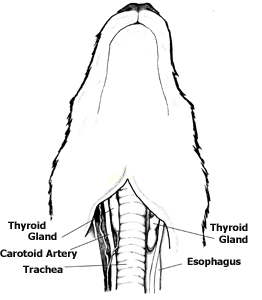What is the Thyroid?
The thyroid is a gland that is located in the throat below the larynx. It's purpose is to produce hormones which control the rate of metabolism; Thyroxine (T4) and Triiodothyronine (T3). It is stimulated into the production of T4 and T3 by Thyroid Stimulating Hormone (cTSH) which is produced by the pituitary gland.
What is Hypothyroidism?
Hypothyroidism is also known as underactive thyroid. It is a condition where the thyroid gland, which produces hormones, Thyroxine (T4) and Triiodothyronine (T3), is dysfunctional and not producing these hormones as required by the body. T4 and T3 are hormones that control the bodies metabolism.
Thyroid dysfunction including the most common, hypothyroidism, is a relatively common endocrine disease in dogs. The thyroid is a complex gland and results can be adversely affected by:
- vaccination;
- other drugs;
- diet supplementation;
- seasons;
- other non thyroid related illness; and
- general wellbeing.
Therefore, issues concerning the thyroid are also considered to one of the most misdiagnosed.
IMPORTANT NOTE
Basenjis have a lower normal reference range to T4 and fT4 than most other breeds. A ground breaking study by the University of Sydney in the early 2000's found that the reference range in Basenjis, and some other sight hounds, can be much lower than the normal ranges accepted for other breeds. It is important that if thyroid dysfunction is considered by a vet that a full thyroid panel is done to include T4/fT4, cTSH as a minimum and its a good idea to have cholesterol checked as well as high cholesterol can be a symptom of thyroid issues. The ranges of T4 and cTSH are evaluated together rather than against their individual reference ranges. A Basenji with low T4 but with cTSH in the normal range and normal cholesterol would generally be considered to have normal thyroid. If the T4 is low and cTSH is getting toward the upper limit of normal and cholesterol is also high a further test in a couple of months would be advisable. A Basenji with low T4 and cTSH much higher than the accepted normal range with or without higher cholesterol would be considered as hypothyroid and medication may be required.
What are the symptoms Hypothyroidism?
Most cases of hypothyroidism are caused by lymphocytic thyroiditis (autoimmune thyroiditis). Idiopathic (of no known cause) is another, rarer, cause of thyroid malfunction. Although lymphocytic thyroiditis is known to be hereditary, the cause of both types is unknown.
The most common symptoms include (%= approximate % of hypothyroid dogs that exhibit that symptom):
- High blood cholesterol 80%
- lethargy 70%
- hair loss 65%
- weight gain 60%
- poor coat condition; often brittle, excessive shedding 60%
- Anaemia 50%
- skin conditions 25%+
- irritability
Tambuzi Health Management Program – Thyroid
Basenji thyroid health and concerns have been long debated amongst Basenji owners. Based on the conclusions of the research conducted in Australia by Dr Aine Seavers, Professor Kenneth Mason BSc BVSc MACVSc MVSc FACVSc, Dr R Malik and D.H. Snow I will only test for thyroid dysfunction when a dog exhibits hypothyroid-like symptoms. It is obvious, that due to inaccurate referencing by some laboratory's many Basenjis are considered hypothyroid, when in fact they are in the breed specific range and are normal. Some laboratory's do not evaluate T4 in concert with cTSH levels and this failure is exacerbating the number of Basenjis that are incorrectly diagnosed. In short a large number of Basenjis are being medicated due to an incorrect referencing of thyroid activity.
Importantly, it is recommended that thyroid function tests should only be performed in dogs with actual clinical signs consistent with hypothyroidism. The situation is thus further complicated when a specific breed society decides to screen breeding stock for hypothyroidism on the basis of an alleged inherited basis for the condition. Driven by ‘abnormal’ results based on inappropriate laboratory reference intervals, which do not take breed differences into account, a situation may arise in which healthy individuals are unnecessarily removed from the gene pool on the basis of such testing. Reference Australian Veterinary Journal Vol 86 No. 11, November 2008.
I will test reactively, that is when a Basenji is showing symtoms of thyroid dysfunction. Depending upon the results:
- further breeding of that animal will be evaluated; and
- if already bred, progeny will be closely monitored.
My breeding program also precludes the testing for TgAA which, as a stand alone test, does not determine a hypothyroid status. This test does not meet the criteria set in my program for the following reasons:
- the test does not determine hypothyroid only that the dog may or may not be positive for thyroglobulin autoantibody;
- the test is not conclusive;
- the test must be run yearly, with only a small percentage of dogs showing any symptoms or testing hypothyroid within the year;
- the test does not determine carriers;
- the test determines, positive, negative results but also has a relatively large percentage range of 'inconclusive' status;
- out of 420 Basenjis tested by the OFA (as at Dec 2013) only 5.5% tested positive for TgAA. Only a small percentage of these will progress to a hypothyroid state within one year of the test; and
- the number of false positives in test results increases exponentially after the dog reaches 5-6 years old. The test should therefore not be used after 5-6 years old.


